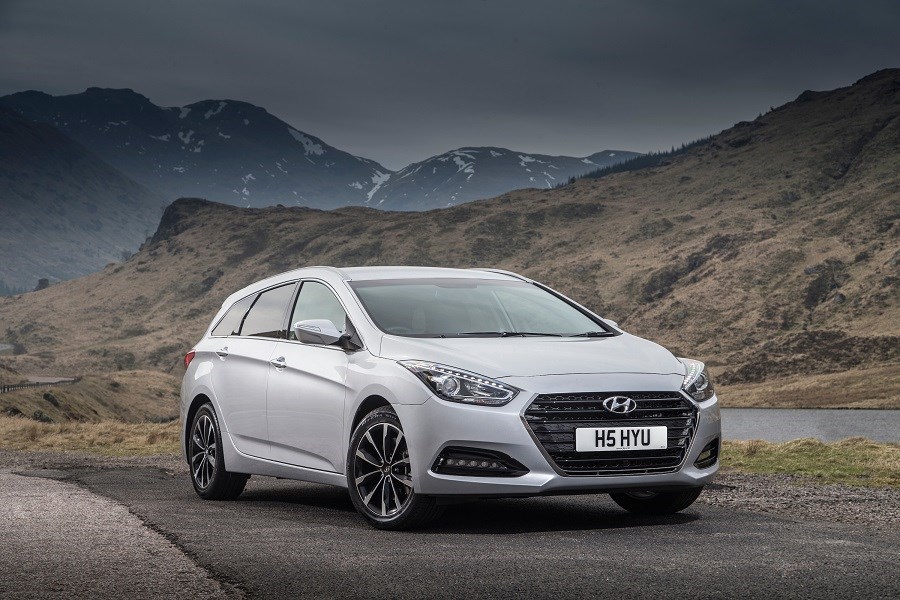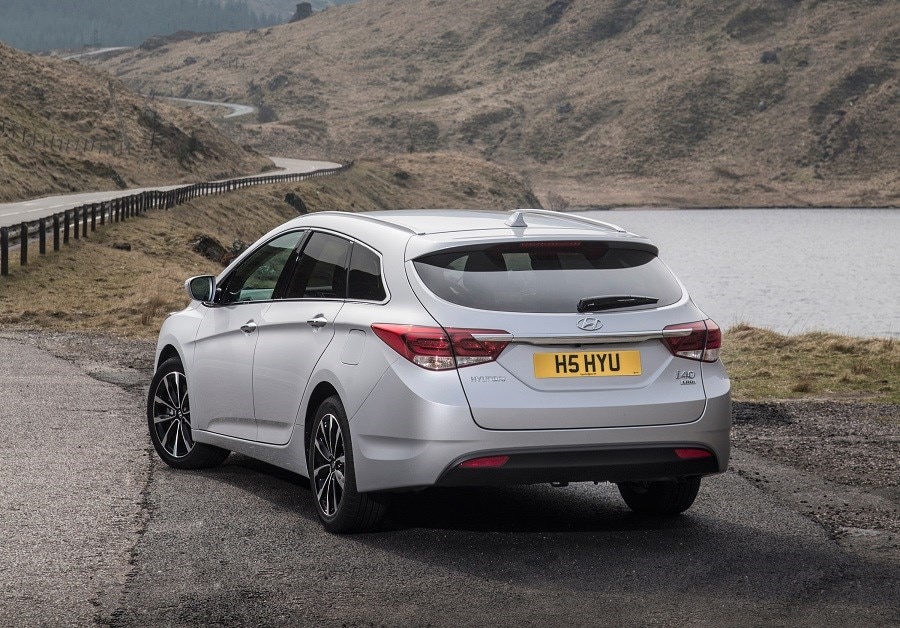Model review
Hyundai unveiled the i40 in estate form at the 2011 Geneva Motor Show. It represented somewhat of a shift for the manufacturer, as it was engineered in Europe with the continent’s motorist in mind. Plus, it was perhaps the most premium model the South Korean marque had ever put to market at that time.
It also possessed a healthy amount of style, but Hyundai didn’t forget about its value-orientated roots; an efficient, wallet-friendly 1.7-litre diesel was available from launch, and for its price bracket, the i40 was very well-equipped.
The saloon version was unveiled later in the year at the Barcelona Motor Show, boasting a swoopy look and the same credentials as the estate version.
Latest model
An updated version of the i40 was shown off in 2014, with both saloon and estate variants going on sale in 2015. The manufacturer credited the revamped i40 as a car that helped shift consumer perception of Hyundai.
Revisions included new front and rear lights, a new Hexagon grille—a trademark feature of Hyundais – and a new front bumper. The design mimicked that of the Genesis, Hyundai’s range-topping model in other parts of the world.
A new seven-speed DCT automatic transmission was added to the line-up, along with an engine range solely consisting of diesel units.
It also showcased some new safety technologies for Hyundai in Europe, including high-beam assist and traffic sign recognition.
Revisions underneath the surface also helped the i40 to remain a comfortable car.
Disappointingly, the i40 seems to have been forgotten about within the range, with no revisions or adjustments being made since 2014.
Value for money
Keeping with one of the things Hyundai is known for, the i40 represents excellent value for money. Saloon models start at £20,360, while the Tourer (estate) can be had from £21,610. It pips the Kia Optima and Ford Mondeo on cost, although it’s more expensive than the excellent Vauxhall Insignia. That said, because the i40 isn’t a best-seller, it’s possible to get up to £2,000 off new models at main dealers. If you’re looking at buying a new one you should never pay the full asking price.
Whilst standard equipment is good, it isn’t overly generous. Nevertheless, automatic lights, LED daytime running lights, electric lumbar support and Bluetooth are all included as standard, which isn’t bad.
Undoubtedly, the i40 makes the most sense on the used market, thanks to heavy depreciation. Used models can be picked up for as little as £3,000, although cars at this price will have high mileages. You could be looking at double that price before you can find an example with less than 60,000 miles, although that’s still a lot of car for the money. We saw a 2012 i40 Tourer with 63,000 miles on the clock for £5,995—which is a great buy.
Low-mileage facelifted versions from 2015 can also be bought from £8,000. However, it’s the nearly-new models which make the best financial case. A six-month old example with under 10,000 miles will set you back around £13,000, which is a substantial saving of over £7,000 compared to its price when new.
Looks and image
While the i40 looked smart when it first went on sale, new models now look a bit dated. The exterior design still looks rather fresh with the cascading grille, big headlights and LED daytime running lights, but next to newer rivals such as the Vauxhall Insignia and Mazda6, the i40 is starting to show its age.
Sadly, the interior doesn’t have a particularly fresh look anymore—particularly the entry-level S versions which don’t even come with a touchscreen. There’s just a few too many buttons compared to newer models, although it’s a layout that’s easy to work. Interior quality is also decent. There aren’t many hard plastics around the cabin, and all trims benefit from a leather steering wheel and gearstick. As you close in on the top of the range, you’ll get a heated steering wheel, heated front and rear seats, as well as a panoramic sunroof.
The i40 is not the car for those wanting a thrilling driving experience, but if comfort is your top priority, it would make an excellent choice. That said, the ride quality is superb—particularly on cars wearing smaller wheels—with the Hyundai’s suspension setup soaking up potholes well. It excels on long-distance journeys and on the motorway, as the oddly-weighted steering wheel and chassis mean that driving it on smaller roads isn’t a particularly dynamic experience.
Space and practicality
Whether you choose the saloon or estate variant of the i40, you won’t be short of interior space. It’s little wonder that the i40 has become such a firm favourite with taxi drivers, as the cabin is truly vast, with room for five adults to sit with comfort, and plenty of legroom and headroom. There’s plenty of interior storage and cubby holes, too.
The saloon’s boot offers 525 litres of space and stretches back a long way. It’s not quite as big as the class favourites, but you’ll rarely be wishing for a bigger boot. The only thing worth noting is that, unlike some rivals, the seats are fixed and cannot be folded. But if you require more room than that, you always have the i40 Tourer. The estate’s 553-litre boot, with all seats in place, isn’t that much bigger than the saloon, but folding the rear seats increases this to an impressive 1,719 litres.
Those looking to tow with their i40 should note that it has a towing capacity between 1,500kg and 1,800kg.
The i40 also scored a five-star Euro NCAP safety rating, with particularly high scores recorded for its adult occupancy protection. The only drawback is that this test was carried out in 2011, and since then safety technology has moved on significantly. The i40 comes with all the must-have safety kit, although it misses out on a lot of the driver aids you’ll find on newer models; it’s only the top-spec versions, which come with lane-departure warning and lane-keep assist as standard.
Engines
Just one engine is available on the i40—the long-serving 1.7-litre diesel unit, which you can have with 113bhp or 139bhp. We recommend the more powerful engine, as that bit of extra grunt makes a lot of difference on a car the size of the i40.
The lower-powered unit comes with a six-speed manual gearbox, while the 139bhp variant has the option of the manual ‘box or a seven-speed DCT automatic transmission. The quicker engine can accelerate from 0-60mph in 10.1 seconds and has a top speed of 126mph.
Hyundai briefly offered the i40 with a 130bhp, 1.6-litre petrol unit, although slow sales forced the firm to axe it from the line-up. There are a limited number of these for sale on the used market.
Running costs
The 1.7-litre diesel unit fitted to the i40 is very efficient, thus keeping running costs cheap. Fuel economy ranges between 60.1 and 67.3mpg, and CO2 emissions from 110 to 123g/km —in other words, it is very clean for its class.
Insurance groupings stack up well, ranging between 13 and 20, servicing costs should be affordable, too.
What to look for
Hyundai has a pretty solid reliability record, with its cars usually regarded as highly-durable. That, combined with the firm’s impressive five-year unlimited mileage warranty makes the i40 ideal for high-mileage drivers.
The only known issue reported with the i40 concerns vehicles built in 2014—some of which had clutch issues. If you’re buying a model from that year, take the car on a thorough test drive and ensure that there’s no difficulty putting it into gear, and that the gearchange feels slick.
Rivals
The family car sector is a market that’s not quite as big as it used to be, although the i40 still has a number of very credible competitors. Sitting at the top as the best car in its class is the Skoda Superb, although other models worth looking at including the Ford Mondeo, Vauxhall Insignia, Mazda6, Peugeot 508 and Kia Optima. As a more premium rival, you could also look at the excellent Volkswagen Passat.
Depreciation
As we’ve mentioned earlier, the i40 is a steal on the used market, with a lack of desirability leading to significantly-lowered values; hefty discounts on brand new models has also had a knock-on effect.





